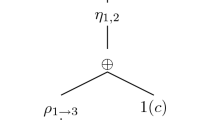Abstract
Determining the maximum number of edges under degree and matching number constraints have been solved for general graphs in Chvátal and Hanson (J Combin Theory Ser B 20:128–138, 1976) and Balachandran and Khare (Discrete Math 309:4176–4180, 2009). It follows from the structure of those extremal graphs that deciding whether this maximum number decreases or not when restricted to claw-free graphs, to \(C_4\)-free graphs or to triangle-free graphs are separately interesting research questions. The first two cases being already settled in Dibek et al. (Discrete Math 340:927–934, 2017) and Blair et al. (Latin American symposium on theoretical informatics, 2020), in this paper we focus on triangle-free graphs. We show that unlike most cases for claw-free graphs and \(C_4\)-free graphs, forbidding triangles from extremal graphs causes a strict decrease in the number of edges and adds to the hardness of the problem. We provide a formula giving the maximum number of edges in a triangle-free graph with degree at most d and matching number at most m for all cases where \(d\ge m\), and for the cases where \(d<m\) with either \(d\le 6\) or \(Z(d)\le m < 2d\) where Z(d) is a function of d which is roughly 5d/4. We also provide an integer programming formulation for the remaining cases and as a result of further discussion on this formulation, we conjecture that our formula giving the size of triangle-free extremal graphs is also valid for these open cases.



Similar content being viewed by others
Data availability
Data sharing not applicable to this article as no datasets were generated or analysed during the current study.
References
Andrásfai B, Erdös P, Sós VT (1974) On the connection between chromatic number, maximal clique and minimal degree of a graph. Discrete Math 8:205–218
Balachandran N, Khare N (2009) Graphs with restricted valency and matching number. Discrete Math 309:4176–4180
Banak AE, Ekim T, Taşkın ZC (2023) Constructing extremal triangle-free graphs using integer programming. Discrete Optim 50:100802. https://doi.org/10.1016/j.disopt.2023.100802
Belmonte R, Heggernes P, van ’t Hof P, Saei R (2012) Ramsey numbers for line graphs and perfect graphs, In: COCOON ’12, pp 204–215
Blair JRS, Heggernes P, Lima PT, Lokshtanov D (2020) On the maximum number of edges in chordal graphs of bounded degree and matching number, In: Latin American symposium on theoretical informatics, pp 600–612. Springer, Cham
Bollobás B (1998) Modern graph theory, graduate texts in mathematics 184. Springer, New York, p 120
Chvátal V, Hanson D (1976) Degrees and matchings. J Combin Theory Ser B 20:128–138
Dibek C, Ekim T, Heggernes P (2017) Maximum number of edges in claw-free graphs whose maximum degree and matching number are bounded. Discrete Math 340:927–934
Erdős P, Rado R (1960) Intersection theorems for systems of sets. J Lond Math Soc 35:85–90
Gallai T (1963) Neuer Beweis eines Tutte’schen Satzes, Magyar Tud. Akad Mat Kutató Int Közl 8:135–139
Häggkvist R (1982) Odd cycles of specified length in nonbipartite graphs. In: Graph theory (Cambridge, 1981), vol 62 of North-Holland Mathematics Studies, North-Holland, pp 89–99
Måland E (2015) Maximum number of edges in graph classes under degree and matching constraints. The University of Bergen, Norway
Turán P (1941) On an extremal problem in graph theory. Mat Fiz Lapok 48:436–452
Vizing VG (1964) On an estimate of the chromatic class of a p-graph, (Russian). Diskret Analiz 3:25–30
Funding
M. Ahanjideh and T. Ekim were supported by TÜBİTAK Grant Number 118F397. M.A. Yıldız was supported by a Marie Skłodowska-Curie Action from the EC (COFUND Grant No. 945045) and by the NWO Gravitation project NETWORKS (Grant No. 024.002.003).
Author information
Authors and Affiliations
Corresponding author
Ethics declarations
Conflict of interest
The authors have no conflict of interest to declare that are relevant to the content of this article.
Additional information
Publisher's Note
Springer Nature remains neutral with regard to jurisdictional claims in published maps and institutional affiliations.
Rights and permissions
Springer Nature or its licensor (e.g. a society or other partner) holds exclusive rights to this article under a publishing agreement with the author(s) or other rightsholder(s); author self-archiving of the accepted manuscript version of this article is solely governed by the terms of such publishing agreement and applicable law.
About this article
Cite this article
Ahanjideh, M., Ekim, T. & Yıldız, M.A. Maximum size of a triangle-free graph with bounded maximum degree and matching number. J Comb Optim 47, 57 (2024). https://doi.org/10.1007/s10878-024-01123-z
Accepted:
Published:
DOI: https://doi.org/10.1007/s10878-024-01123-z




